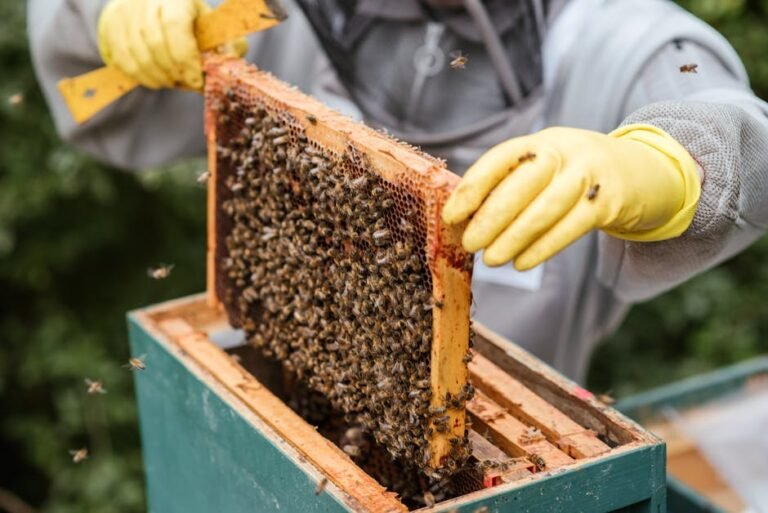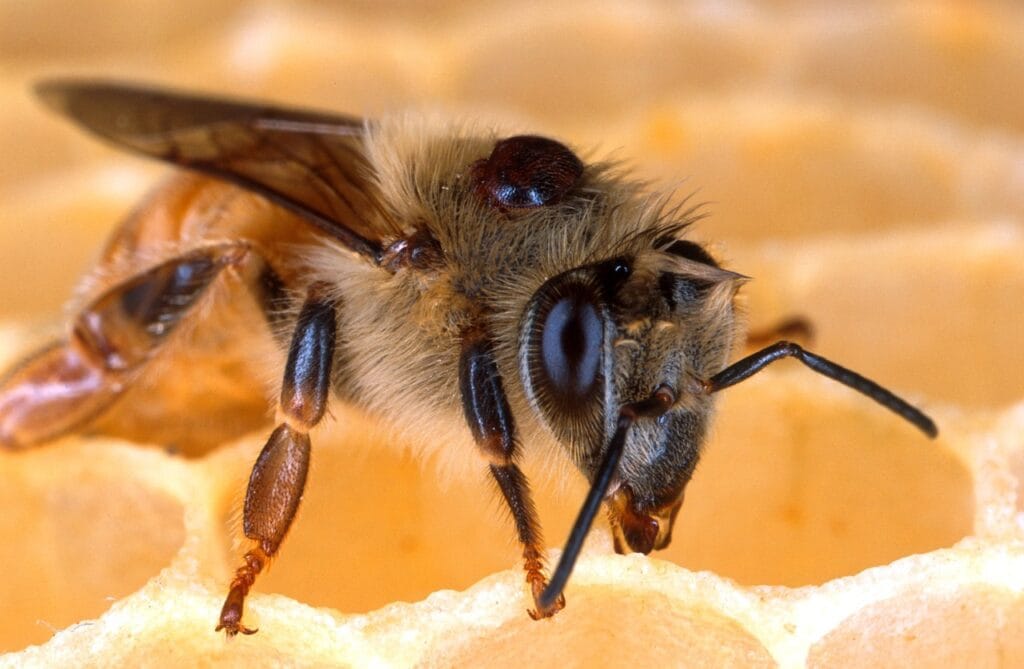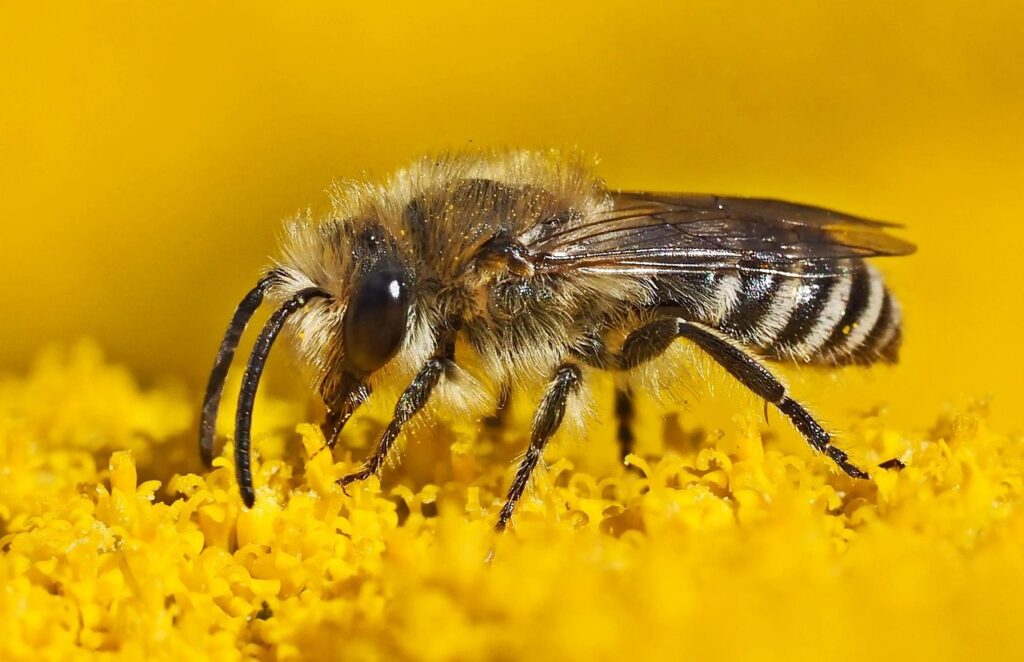Summer beekeeping requires a strategic shift from spring’s growth focus to production optimization and heat management. During this peak season, colonies reach maximum population while facing the dual challenges of intense nectar flows followed by potential summer dearth.
The management decisions made during summer directly impact both current honey production and the colony’s ability to survive the following winter.[1][2][3]
Critical Summer Beekeeping Tasks
1. Conduct Regular Colony Inspections
What to Do: Inspect hives every 7-10 days during active nectar flows, then reduce to bi-weekly or monthly during summer dearth periods. Focus on queen status, population levels, and space needs rather than exhaustive frame examinations.[4][5][6][1]
Why It’s Essential: Summer inspections serve multiple critical purposes beyond basic health monitoring. They allow early detection of swarming preparations, which can still occur through early summer despite peak season timing. Regular monitoring helps identify the transition from nectar flow to dearth, requiring immediate management adjustments.[2][5][7][8][9][4]
Inspection Timing: Conduct inspections during cooler parts of the day (early morning or evening) to minimize heat stress and reduce robbing attraction. Limit inspection time to 15-20 minutes maximum during hot weather.[10][11]
2. Maximize Honey Production Through Space Management
What to Do: Add honey supers when existing supers are 80% full, staying ahead of the bees’ storage needs. Monitor nectar flow intensity through daily hive observations and weight changes.[12][5][13][14]
Why It’s Critical: Proper space management is essential for preventing late-season swarming and maximizing honey yields during peak nectar flows. The late spring/early summer nectar flow typically produces the majority of harvestable honey for the year. Inadequate space forces bees to reduce foraging efficiency and may trigger reproductive swarming behavior even during productive periods.[7][13][14][15][12]
Timing Strategy: Add supers proactively based on nectar flow indicators: increased hive activity, visible nectar in cells, and rapid comb building. Remove empty supers during dearth periods to help bees defend smaller spaces.[3][6][13][9]
3. Implement Heat Stress Management
What to Do: Provide adequate ventilation through screened bottom boards, propped covers, and upper entrances. Ensure reliable water sources within 50 feet of hives.[16][17][18][11][1][4]
Why It’s Necessary: Heat stress above 95°F significantly impacts colony productivity and can cause catastrophic damage including melted comb, brood death, and colony abandonment. Bees must divert energy from honey production to cooling when temperatures exceed their comfort range. Water becomes critical for evaporative cooling, with colonies potentially requiring several gallons daily during extreme heat.[17][18][11][16]
Management Strategies: Watch for bearding behavior (bees clustering outside the hive) as an indicator of internal heat stress. Provide shade during peak afternoon hours while maintaining morning sun exposure.[6][11][7][16][17]
4. Monitor and Prevent Robbing Behavior
What to Do: Reduce hive entrances at the first sign of nectar dearth and keep inspection time minimal. Avoid leaving honey, equipment, or sweet substances near hives.[19][20][21][22][10]
Why Prevention is Critical: Robbing behavior can devastate colonies faster than winter losses, with strong hives being completely stripped of stores within days. Once robbing begins, it attracts multiple colonies and predators like yellowjackets, creating a feeding frenzy that can destroy even strong colonies. Robbing also transfers varroa mites and diseases between colonies, spreading problems throughout the apiary.[20][21][22]
Early Warning Signs: Increased fighting at entrances, bees carrying out debris, and unusual activity during non-foraging hours. Italian bees are particularly prone to robbing behavior and require extra vigilance.[21][22][19]
5. Harvest Honey at Optimal Timing
What to Do: Harvest when frames are at least 80% capped, typically in mid to late summer before fall dearth begins. Leave adequate stores (30-60 pounds depending on region) for winter survival.[5][8][4][3]
Why Timing Matters: Early harvesting during active nectar flows reduces robbing risks and allows easier bee management. Waiting too long risks losing honey to late-season consumption or robbing during dearth periods. The timing also affects honey quality, with different floral sources producing distinct flavors throughout the season.[14][8][9]
Harvesting Strategy: Remove only fully capped frames to ensure proper moisture content and prevent fermentation. Complete harvest operations quickly and keep extracted honey covered to minimize robbing attraction.[8][21]
6. Maintain Vigilant Pest Monitoring
What to Do: Conduct monthly varroa mite counts using alcohol wash or sugar shake methods. Monitor for small hive beetles, wax moths, and other summer pests that thrive in warm weather.[23][12][2][4]
Why Summer Monitoring is Critical: Varroa mite populations peak during summer months while bee populations are also at maximum, creating ideal conditions for rapid mite reproduction. High mite loads during summer directly impact the health of winter bees being produced in late summer. Small hive beetles and wax moths become increasingly active in warm weather, particularly targeting weaker colonies.[2][23]
Treatment Considerations: Summer treatments must account for honey production restrictions and temperature limitations. Many treatments cannot be applied during honey flows or when temperatures exceed specific ranges.[23]
7. Support Colonies During Summer Dearth
What to Do: Recognize dearth conditions through reduced foraging activity, increased defensiveness, and absence of fresh nectar. Provide emergency feeding only when necessary, using internal feeders to avoid attracting robbers.[9][20][8]
Why Dearth Management Matters: Summer dearth can be more devastating than winter because it strikes when colonies are at peak population with maximum food requirements. Large colonies can quickly exhaust stored honey, leading to starvation or triggering robbing behavior. Proper dearth management maintains colony strength for potential fall nectar flows.[20][9]
Feeding Protocol: Use 1:1 or 2:1 sugar syrup in enclosed feeders to avoid attracting robbers. Avoid essential oil additives during dearth periods as they increase attractant effects.[20]
Seasonal Integration and Success Factors
Understanding Natural Cycles: Summer management requires recognizing the natural progression from active nectar flows to dearth periods. This transition typically occurs in mid-summer when spring flowers finish and fall blooms haven’t yet begun.[14][8][9][20]
Regional Adaptation: Summer dearth timing and intensity vary significantly by geographic location. Northern regions may experience shorter, more intense dearths, while southern areas might have prolonged dry periods.[14][20]
Long-term Impact: Summer management decisions directly affect winter preparation. Colonies that maintain strength through summer dearth are better positioned to capitalize on fall nectar flows and build adequate winter stores.[18][3][20]
Summary
Summer beekeeping represents the culmination of the annual cycle’s productive potential, requiring careful balance between maximizing current honey production and maintaining colony health for future seasons.
Success depends on understanding the dynamic nature of nectar availability and adapting management strategies to support colonies through both abundance and scarcity periods.
⁂
- https://www.ecrotek.co.nz/learn/articles/detail/your-summer-beekeeping-checklist
- https://blythewoodbeecompany.com/blogs/news/summer-beekeeping
- https://thebeesupply.com/blogs/beekeepers-blog/summer-hive-care
- https://www.honeytruck.com/blogs/bee-blog/summer-beekeeping-duties
- https://www.mannlakeltd.com/blog/your-summer-beekeeping-todo-list/
- https://www.beekeepingmadesimple.com/blog/beekeeping-heat-bearding-robbing
- https://rockymountainbeesupply.com/pages/beekeepers-calendar
- https://mastersons.net/blog/2020/7/13/summer-in-the-beehive
- https://www.honeybeesuite.com/summer-nectar-dearth-honey-bee-management/
- https://www.youtube.com/watch?v=_ZdhZ05eJlQ
- https://thebfarm.com/blogs/news/how-to-keep-your-bees-cool-and-hydrated-in-the-summer
- https://honestbeeltd.com/faqs/what-is-the-focus-of-hive-management-during-summer
- https://thebeesupply.com/blogs/beekeepers-blog/how-to-know-when-the-nectar-flow-begins-and-when-to-add-a-honey-super
- https://beeculture.com/nectar-flow-be-ready/
- https://www.blog-veto-pharma.com/en/managing-space-in-honey-bee-colonies-and-adding-honey-supers-in-spring/
- https://blythewoodbeecompany.com/blogs/news/keeping-your-hive-cool-beekeeping-tips-for-rising-spring-temperatures
- https://www.homesweetbees.com/beekeeping/2025/7/25/helping-bees-during-heat-advisories
- https://usa.hivealivebees.com/blogs/news/high-summer-heat-and-your-bee-hives-heat-stress-in-bees
- https://www.honeybeesuite.com/stealing-honey-bee-on-bee-robbery/
- https://www.dadant.com/learn/the-importance-of-recognizing-and-addressing-summer-nectar-dearth-for-beekeepers/
- https://hbrc.ca/robbing-prevention/
- https://ecrotek.com.au/blogs/articles/beekeeping-101-how-to-stop-hive-robbing
- https://www.thekeepershive.com/pages/overview-of-seasonal-management-tasks
- https://hbrc.ca/beekeepers-checklist/
- https://talkingwithbees.com/beekeeping-how-to-guides/beekeeping-calendar
- https://www.beekeepingfornewbies.com/managing-beehives-in-summer/
- https://www.montana.edu/extension/bigskybees/YearintheHive.html
- https://cals.cornell.edu/pollinator-network/beekeeping/beekeeping-calendar-northeast



